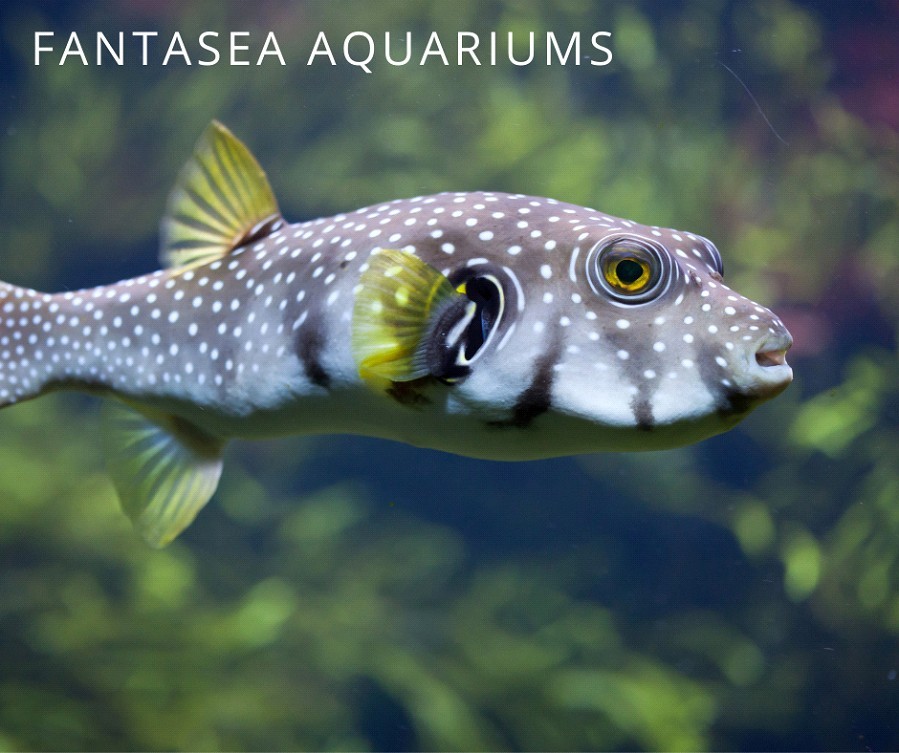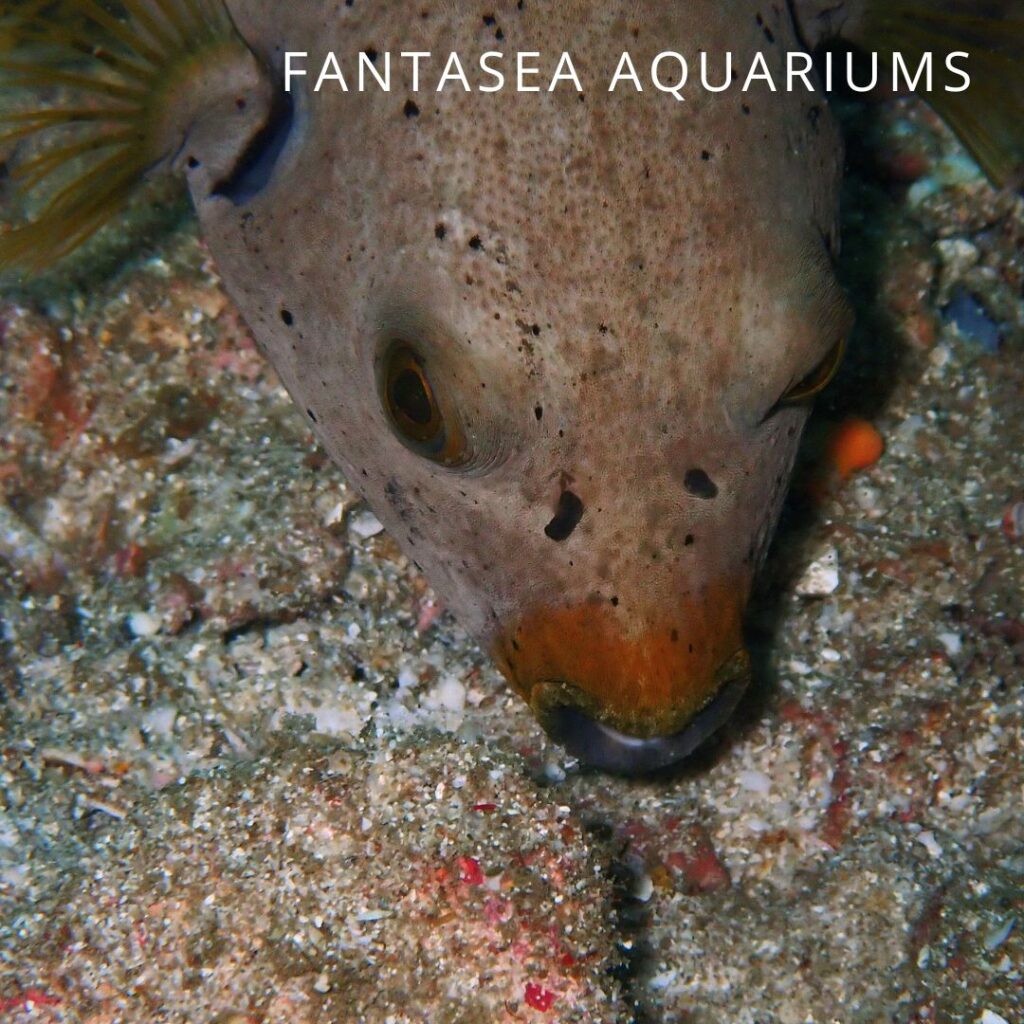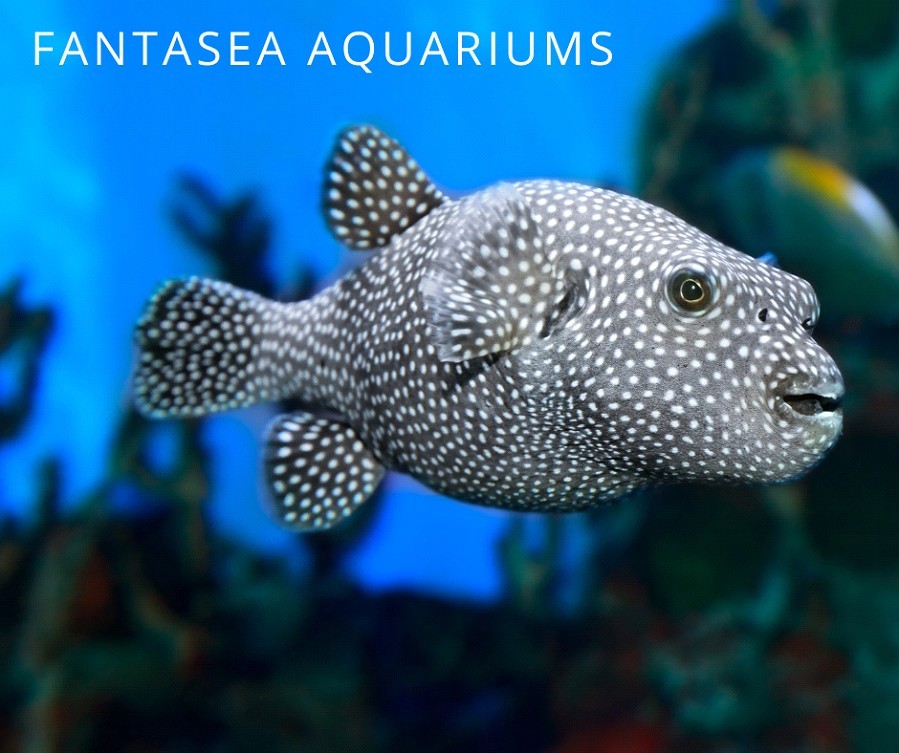Keeping a puffer fish as a pet can be a rewarding experience, and at PETS.EDU.VN, we’re here to guide you through the process. With their unique appearance and engaging personalities, puffer fish make fascinating additions to home aquariums, offering endless hours of observation and interaction. Discover if puffer fish are the right pet for you, along with essential care tips, tank setup advice, and feeding guidelines. Explore related topics such as aquarium maintenance, fish health, and aquatic pet care.
1. Understanding Puffer Fish as Pets
Puffer fish, also known as blowfish, are captivating creatures that can make unique pets. However, keeping them requires knowledge and dedication. Let’s delve into what makes puffer fish special and what you need to know before bringing one home.
1.1. What Makes Puffer Fish Unique?
Puffer fish are known for several distinctive features:
- Inflation: They can inflate their bodies with water or air when threatened, making them appear larger and deterring predators.
- Intelligence: Puffer fish are remarkably intelligent, often recognizing their owners and exhibiting playful behavior.
- Diet: Their diet consists of hard-shelled invertebrates, which helps keep their teeth from overgrowing.
- Appearance: With various species boasting vibrant colors and patterns, puffer fish add beauty to any aquarium.
1.2. Are Puffer Fish Right for You?
Before getting a puffer fish, consider the following:
- Commitment: Puffer fish require specialized care and a long-term commitment, with some species living over ten years.
- Tank Size: Depending on the species, puffer fish need appropriately sized tanks to thrive.
- Diet: You must be prepared to provide a varied diet that includes hard-shelled foods.
- Temperament: Some puffer fish can be aggressive, so choosing compatible tank mates is crucial.
1.3. Legal Considerations
In some regions, certain puffer fish species may be regulated or prohibited. Always check local laws and regulations before acquiring one. PETS.EDU.VN advises responsible pet ownership, which includes understanding and adhering to all legal requirements.
2. Choosing the Right Puffer Fish Species
Selecting the right puffer fish species is vital for ensuring a successful and enjoyable pet-keeping experience. Different species have varying care requirements, temperaments, and sizes.
2.1. Popular Puffer Fish Species
Here are some popular puffer fish species commonly kept as pets:
- Dwarf Puffer (Carinotetraodon travancoricus): Small and relatively peaceful, ideal for smaller tanks.
- Figure 8 Puffer (Tetraodon biocellatus): Recognizable by the figure-8 pattern on its back, requires brackish water.
- Green Spotted Puffer (Tetraodon nigroviridis): Another brackish water species, known for its vibrant green coloration.
- Stars and Stripes Puffer (Arothron hispidus): A larger species needing a substantial tank, known for its distinctive pattern.
- Valentini Puffer (Canthigaster valentini): A smaller marine puffer, suitable for reef tanks with caution.
- Dog Faced Puffer (Arothron nigropunctatus): Known for their puppy-like faces, these puffers require larger tanks.
- Guineafowl Puffer (Arothron meleagris): These larger puffers are sure to make a statement in your aquarium.
- Blue Spotted Puffer (Canthigaster solandri): These marine puffers are beautiful with their intricate designs.
2.2. Size and Tank Requirements
Different puffer fish species require different tank sizes:
| Species | Adult Size | Minimum Tank Size |
|---|---|---|
| Dwarf Puffer | 1 inch | 5 gallons |
| Figure 8 Puffer | 3 inches | 20 gallons |
| Green Spotted Puffer | 6 inches | 30 gallons |
| Stars and Stripes Puffer | 18 inches | 250 gallons |
| Valentini Puffer | 4.5 inches | 30 gallons |
| Dog Faced Puffer | 13 inches | 100 gallons |
| Guineafowl Puffer | 20 inches | 250 gallons |
| Blue Spotted Puffer | 5 inches | 50 gallons |




2.3. Temperament and Compatibility
Puffer fish temperaments vary widely. Some are peaceful and can coexist with other fish, while others are aggressive and best kept alone. Research the specific species you’re interested in to ensure compatibility with any existing or planned tank mates.
- Peaceful Species: Dwarf puffers can sometimes be kept in groups or with small, peaceful fish.
- Semi-Aggressive Species: Figure 8 and green spotted puffers can be territorial and may nip at the fins of slower-moving fish.
- Aggressive Species: Larger puffers like the stars and stripes puffer are best kept in single-species tanks due to their aggressive nature.
3. Setting Up the Ideal Puffer Fish Tank
Creating the right environment is crucial for the health and well-being of your puffer fish. A well-maintained tank mimics their natural habitat and promotes a stress-free life.
3.1. Tank Size and Shape
Choose a tank that meets the minimum size requirements for your chosen species. A longer tank is generally better than a taller one, providing more swimming space. According to a study by the University of Florida’s Tropical Aquaculture Laboratory in 2022, providing adequate space reduces stress and promotes healthier behavior in captive fish.
3.2. Water Parameters
Puffer fish require specific water parameters to thrive:
- Temperature: Maintain a stable temperature between 76°F and 82°F (24°C to 28°C).
- pH: Keep the pH level between 7.0 and 8.0.
- Salinity: Brackish water species like figure 8 and green spotted puffers require a specific gravity between 1.005 and 1.015. Marine species need a salinity of 1.020 to 1.025.
- Ammonia and Nitrites: These should always be at 0 ppm (parts per million).
- Nitrates: Keep nitrates below 20 ppm through regular water changes.
3.3. Filtration System
A robust filtration system is essential to maintain water quality. Consider the following:
- Mechanical Filtration: Removes particulate matter.
- Chemical Filtration: Removes dissolved organic compounds and toxins.
- Biological Filtration: Cultivates beneficial bacteria that convert ammonia and nitrites into less harmful nitrates.
According to research from Auburn University’s Department of Fisheries and Allied Aquacultures in 2023, a well-established biological filter is crucial for the long-term health of aquarium fish.
3.4. Substrate and Decorations
- Substrate: Use aquarium-safe gravel or sand.
- Decorations: Provide plenty of hiding places with rocks, caves, and driftwood. Live plants can also be added, but be aware that some puffer fish may nibble on them.
3.5. Lighting
Moderate lighting is sufficient for most puffer fish species. Avoid excessively bright lights, which can cause stress.
4. Feeding Your Puffer Fish
A proper diet is crucial for the health and well-being of your puffer fish. These fish have unique dietary needs that must be met to prevent health issues.
4.1. What Do Puffer Fish Eat?
Puffer fish are natural predators that feed on a variety of invertebrates. In the aquarium, their diet should include:
- Snails: Essential for keeping their teeth worn down.
- Crabs: Provide necessary nutrients and help with tooth maintenance.
- Shrimp: Offer a good source of protein.
- Worms: Bloodworms, blackworms, and tubifex worms are excellent treats.
- Shell-on Foods: Clams, mussels, and oysters provide calcium and help with tooth wear.
4.2. Feeding Frequency and Quantity
- Juveniles: Feed small amounts 2-3 times per day.
- Adults: Feed once or twice a day, providing only as much food as they can consume in a few minutes.
Overfeeding can lead to obesity and water quality issues.
4.3. Preventing Tooth Overgrowth
Puffer fish teeth continuously grow, and they need to grind them down by eating hard-shelled foods. Neglecting this can lead to overgrown teeth, making it difficult for them to eat. If tooth overgrowth occurs, a veterinarian may need to trim their teeth. PETS.EDU.VN recommends regular dental check-ups for your puffer fish to ensure their teeth are healthy.
4.4. Nutritional Supplements
Consider supplementing their diet with vitamins and minerals to ensure they receive all the necessary nutrients.
5. Maintaining Water Quality
Maintaining excellent water quality is vital for the health of your puffer fish. Poor water conditions can lead to stress, disease, and even death.
5.1. Regular Water Changes
Perform partial water changes regularly to remove nitrates and replenish essential minerals:
- Frequency: 25-50% water change every 1-2 weeks.
- Procedure: Use a gravel vacuum to remove debris from the substrate.
5.2. Testing Water Parameters
Regularly test the water parameters to ensure they are within the appropriate range:
- Frequency: At least once a week.
- Tools: Use a reliable aquarium test kit.
5.3. Avoiding Overcrowding
Overcrowding can quickly lead to poor water quality. Ensure your tank is appropriately sized for the number and size of fish you keep.
5.4. Proper Waste Management
Puffer fish are messy eaters and produce a lot of waste. A strong filtration system and regular maintenance are essential to manage waste effectively.
6. Health and Disease Prevention
Puffer fish are susceptible to various diseases and health issues. Understanding common ailments and how to prevent them is crucial for responsible pet ownership.
6.1. Common Diseases in Puffer Fish
- Ich (White Spot Disease): Characterized by small white spots on the body and fins.
- Fin Rot: Bacterial infection causing the fins to appear frayed and damaged.
- Parasitic Infections: Various parasites can infest puffer fish, causing symptoms like scratching and loss of appetite.
- Internal Parasites: These can lead to weight loss and lethargy.
6.2. Recognizing Signs of Illness
Early detection is critical for successful treatment. Watch for the following signs of illness:
- Loss of Appetite
- Lethargy
- Erratic Swimming
- Clamped Fins
- Abnormal Spots or Lesions
- Rapid Breathing
- Inflated Body (when not threatened)
6.3. Quarantine Procedures
When introducing new fish to your aquarium, quarantine them for several weeks to ensure they are disease-free. According to research published in the Journal of Fish Diseases in 2024, quarantining new fish can significantly reduce the risk of disease outbreaks in the main aquarium.
6.4. Treatment Options
Consult with a veterinarian specializing in aquatic animals for appropriate treatment options. Common treatments include:
- Medications: Antibiotics, antiparasitics, and antifungals.
- Saltwater Dips: Can help treat certain external parasites.
- Improved Water Quality: Often, improving water quality can help fish recover from minor illnesses.
7. Handling and Interaction
Puffer fish are intelligent and can form bonds with their owners, but handling them requires caution.
7.1. Safe Handling Techniques
Never handle a puffer fish unless absolutely necessary. If you must move one, use a soft net and keep the fish submerged in water. Avoid squeezing or stressing the fish.
7.2. Avoiding Bites
Puffer fish have strong jaws and sharp teeth. Be cautious when working in the tank to avoid bites.
7.3. Recognizing Your Puffer Fish
Puffer fish can recognize their owners and may exhibit playful behavior when they approach the tank.
8. Breeding Puffer Fish
Breeding puffer fish in captivity can be challenging, but it is possible with certain species.
8.1. Creating Breeding Conditions
- Water Parameters: Maintain optimal water parameters for the specific species.
- Spawning Tank: Provide a separate spawning tank with suitable substrate and decorations.
- Diet: Offer a high-quality diet rich in protein.
8.2. Identifying Breeding Behavior
- Courtship: Observe for courtship behaviors, such as fin displays and chasing.
- Egg Laying: Some species lay eggs on plants or substrate.
8.3. Raising Fry
- Separate Fry: Remove the parents after spawning to prevent them from eating the fry.
- Feeding Fry: Feed the fry small live foods like baby brine shrimp and infusoria.
9. Ethical Considerations
Responsible pet ownership includes considering the ethical implications of keeping puffer fish.
9.1. Sourcing Puffer Fish
Purchase puffer fish from reputable breeders or stores that prioritize ethical sourcing. Avoid buying wild-caught fish, which can deplete natural populations.
9.2. Providing Adequate Care
Ensure you can provide the necessary care, including appropriate tank size, diet, and water quality. Neglecting their needs can lead to suffering and premature death.
9.3. Rehoming Options
If you can no longer care for your puffer fish, find a suitable new home. Contact local aquarium clubs, rescue organizations, or experienced hobbyists.
10. Advanced Puffer Fish Care
For experienced aquarists, advanced puffer fish care can involve more specialized techniques.
10.1. Aquascaping
Create a visually appealing and functional aquascape that meets the specific needs of your puffer fish.
10.2. Advanced Filtration
Utilize advanced filtration methods like protein skimmers and refugiums to maintain pristine water quality.
10.3. Reef Tank Compatibility
With careful planning and species selection, some smaller puffer fish can be kept in reef tanks. However, it’s essential to monitor their behavior and ensure they don’t harm corals or invertebrates.
11. Common Misconceptions About Puffer Fish
There are several common misconceptions about puffer fish that can lead to improper care.
11.1. Myth: Puffer Fish Can Inflate at Will
Puffer fish inflate as a defense mechanism when threatened. Frequent inflation can be stressful and harmful.
11.2. Myth: Puffer Fish Are Always Aggressive
While some species are aggressive, others are relatively peaceful and can coexist with other fish.
11.3. Myth: Puffer Fish Only Eat Snails
While snails are an important part of their diet, puffer fish need a varied diet to meet their nutritional needs.
12. Resources for Puffer Fish Keepers
Numerous resources are available to help you care for your puffer fish.
12.1. Online Forums and Communities
Join online forums and communities dedicated to puffer fish keeping to connect with other enthusiasts and experts.
12.2. Books and Articles
Read books and articles on puffer fish care to expand your knowledge and understanding.
12.3. Local Aquarium Clubs
Join a local aquarium club to learn from experienced hobbyists and participate in workshops and events.
13. The Joy of Keeping Puffer Fish
Despite the challenges, keeping puffer fish can be a rewarding and enjoyable experience. Their unique personalities and captivating behavior make them fascinating pets.
13.1. Observing Their Behavior
Spend time observing your puffer fish to learn their individual quirks and behaviors.
13.2. Building a Bond
Puffer fish can recognize their owners and may even interact with them, creating a unique bond.
13.3. The Beauty of a Healthy Puffer Fish
A healthy and well-cared-for puffer fish is a beautiful and vibrant addition to any aquarium.
14. Frequently Asked Questions (FAQ) About Puffer Fish
14.1. Can you keep a puffer fish as a pet in a small tank?
No, puffer fish require tanks appropriate to their adult size. Dwarf puffers can live in tanks as small as 5 gallons, but larger species need 100 gallons or more.
14.2. What do puffer fish eat in captivity?
Puffer fish eat snails, crabs, shrimp, worms, and other invertebrates. A varied diet is essential for their health.
14.3. How often should I feed my puffer fish?
Feed juvenile puffer fish 2-3 times per day and adult puffer fish once or twice a day.
14.4. How can I prevent tooth overgrowth in puffer fish?
Provide hard-shelled foods like snails, crabs, and clams to help wear down their teeth.
14.5. What water parameters are ideal for puffer fish?
Maintain a temperature between 76°F and 82°F, a pH between 7.0 and 8.0, and appropriate salinity levels for the specific species.
14.6. How often should I perform water changes in my puffer fish tank?
Perform 25-50% water changes every 1-2 weeks.
14.7. What are some common diseases that affect puffer fish?
Common diseases include ich, fin rot, and parasitic infections.
14.8. Can puffer fish live with other fish?
Some puffer fish species are peaceful and can live with other fish, while others are aggressive and best kept alone.
14.9. How long do puffer fish live?
The lifespan of puffer fish varies by species, but many can live for 5-10 years or more.
14.10. Where can I buy a puffer fish?
Purchase puffer fish from reputable breeders or stores that prioritize ethical sourcing.
15. Conclusion: Is a Puffer Fish Right for You?
Keeping a puffer fish as a pet can be a uniquely rewarding experience for those prepared to meet their specific needs. Their intelligence, unique appearance, and engaging personalities make them fascinating additions to the right home aquarium. At PETS.EDU.VN, we hope this comprehensive guide has provided you with the essential information to make an informed decision about whether a puffer fish is the right pet for you. From understanding their dietary requirements and tank setups to recognizing signs of illness and ethical sourcing, responsible ownership is key to ensuring the health and happiness of these captivating creatures.
Ready to dive deeper into the world of puffer fish and other aquatic pets? Visit PETS.EDU.VN today for more expert advice, detailed care guides, and a wealth of resources to help you become the best pet owner you can be. Explore articles on aquarium maintenance, fish health, and creating the perfect aquatic environment for your new companion. For personalized guidance and support, don’t hesitate to reach out to us at 789 Paw Lane, Petville, CA 91234, United States, or connect with us via Whatsapp at +1 555-987-6543. Let pets.edu.vn be your trusted partner in aquatic pet care!